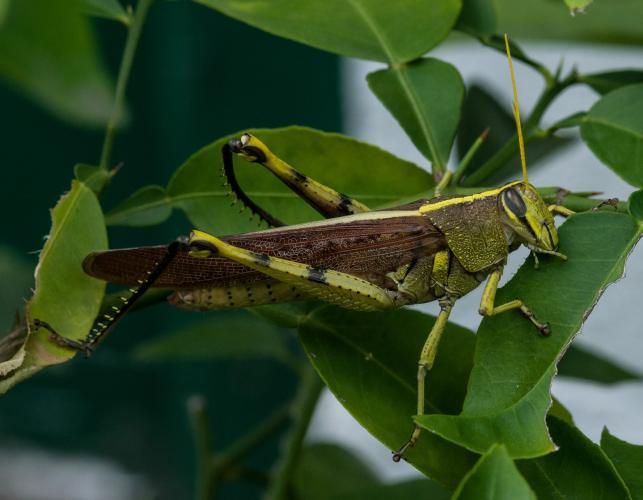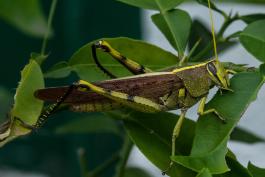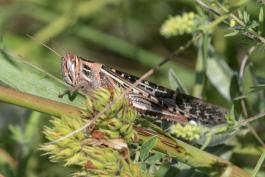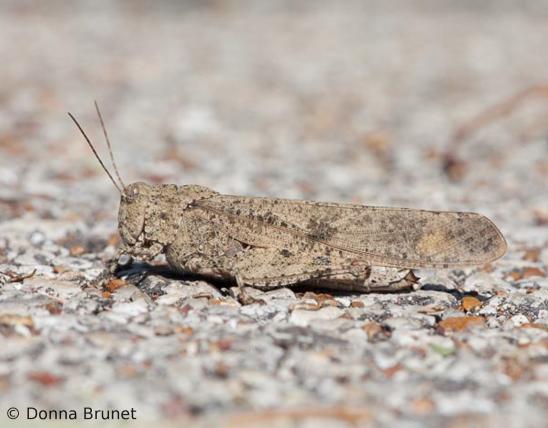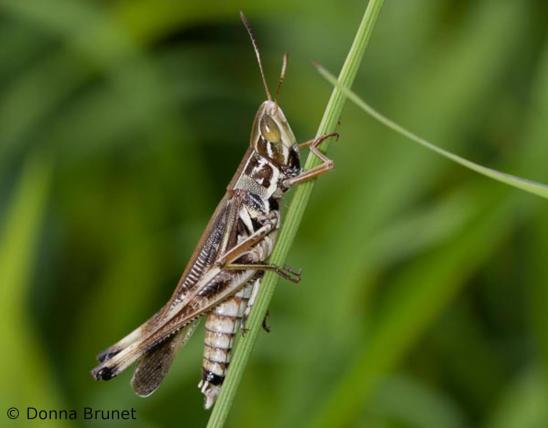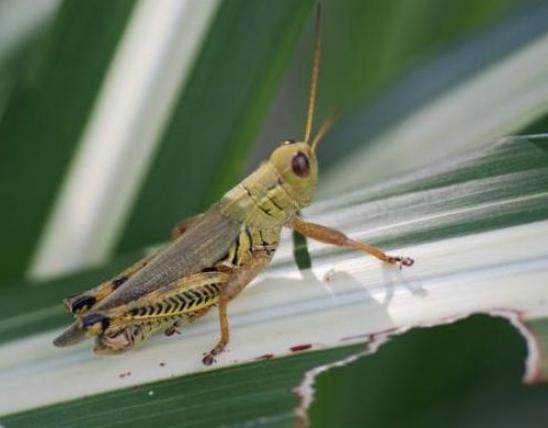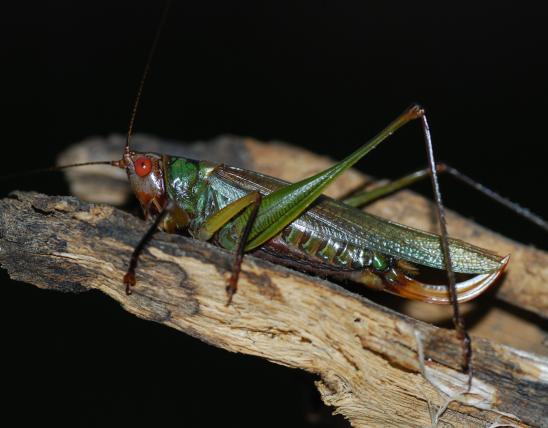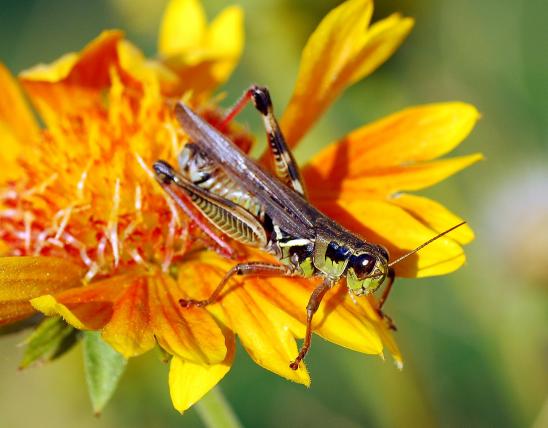
Bird grasshoppers (Schistocerca spp.) are a genus of short-horned grasshoppers. Most are large, long-bodied hoppers, with large wings, and many can fly gracefully — almost floating — away from danger and up into trees. Many species have attractive colors and markings, with olive-green bodies; darker, sometimes reddish forewings; a pale stripe running down the head and onto the back, and spotted wings or splashes of bright yellow on the body.
Bird grasshoppers are one of the groups in the short-horned grasshopper family that have a small spine or pointed, peglike bump on the prosternum (the “throat” or “neck,” on the underside, between the front legs); thus they are sometimes called “spur-throated” grasshoppers — however, they are not in the subfamily that’s officially called the “spur-throated grasshoppers” (subfamily Melanoplinae). Instead, bird grasshoppers are in their own subfamily, the Cyrtacanthacridinae.
As with other grasshoppers and katydids, juvenile bird grasshoppers look something like smaller versions of the adults. Juveniles do not have fully developed wings, however, and in some species the coloration and markings can be quite different than the adult.
Approximately 6 species of bird grasshoppers occur in Missouri:
- American bird grasshopper (S. americana). A large grasshopper with ornate markings. To separate it from other long-bodied, ornate grasshoppers (such as the admirable grasshopper, which is not closely related), note differences in markings, including the large, creamy stripe running down the back from the head to the wings; a dark spot on each side of the pronotum that is split in two by a narrow pale stripe; a white spot on the side of the knees; and the spotted wings. Also note the overall body shape and proportions, including the head shape.
- Obscure bird grasshopper (S. obscura). Belongs to a group of similar, closely related species called the S. alutacea group. This common species is distinguished by its olive-green body; darker green, grayish, or reddish-brown forewings; bright yellow, green, or white spot on the otherwise dark knee joint; another bright yellow or green spot on each side of the thorax (behind the shoulderlike pronotum); 2 dark bars on the upper surface of the femur; and a yellow stripe along the back.
- Leather-colored bird grasshopper (S. alutacea). The namesake for the group of similar, closely related species called the S. alutacea group. The leather-colored bird grasshopper has sometimes been considered a wide-ranging, very diverse single species, with its closest relatives treated as subspecies. Most scientists, however, now limit S. alutacea to a single form and split away, as separate species, insects such as the obscure, rusty, and spotted bird grasshoppers. Compared to its closely related lookalikes in Missouri, the leather-colored bird grasshopper is more plainly marked; you could think of it as the “base model” for this subgroup of bird grasshoppers.
- Spotted, or lined bird grasshopper (S. lineata). Belongs to the S. alutacea group. Very widespread in the United States, with several regional forms and color patterns, ranging from shades of yellow, brown, or green. Like most others in its group, there is usually a pale stripe running down the back. It is distinguished by the thorax having pits and yellowish dots; a lack of yellow spots on the side of the body in front of the hind legs; rows of black dots on the rear margins of the segments on the side of the abdomen; and a pale spot on the knee, with black surrounding the front and top edge of the spot. On males, the femur segments of the front and middle pairs of legs are swollen, looking a little like muscular biceps.
- Rusty bird grasshopper (S. rubiginosa). Also belongs to the S. alutacea group. It is distinguished from S. alutacea and other close relatives by speckles or spots on the folded wings; the lack of a clearly contrasting pale stripe down the back; a usually reddish overall coloration (sometimes tans or grays; only very rarely is it green); and (in males) a lack of thickened femurs on front and middle legs.
- Mischievous bird grasshopper (S. damnifica). Our smallest bird grasshopper, with the largest females not exceeding 2 inches in length. It is mostly unmarked, smooth-looking brown, sometimes with a red or yellow cast; it sometimes has a pale stripe along the back; its shoulderlike pronotum has a distinct, rooflike ridge; and the folded wings are sometimes spotted (faintly). The wings are proportionately not as long as in other bird grasshoppers, extending only slightly beyond the abdomen tip; the antennae are relatively short and thick.
Learn more about the short-horned grasshopper family on their group page.
Adult length varies with species; females are usually larger than males. Bird grasshoppers are some of Missouri’s largest short-horned grasshoppers. Females of some of our typical species, such as the American and obscure bird grasshoppers, may reach 2½ or 2¾ inches. Our smallest species, the mischievous bird grasshopper, only reaches 1⅜ inches (males) and 1⅞ inches (females). Insect length measurements don’t include appendages such as antennae, legs, and wings.
Statewide. Different species have slightly different habitat preferences, so they may have slightly different regional distributions within the state.
Habitat and Conservation
Different species of bird grasshoppers may have slightly different habitat preferences, but most prefer open, grassy areas such as prairies, pastures, old fields, roadsides, gardens, and similar places. Open woodlands and the boundaries of grassy areas with wooded areas are other likely habitats.
Food
Foliage of nonwoody and woody plants. Like most other short-horned grasshoppers, bird grasshoppers chew a wide variety of plants. They are generalists, not limited to certain species or families of plants.
Life Cycle
Like other members of the short-horned grasshopper family (Acrididae), bird grasshoppers go through simple metamorphosis: after hatching from an egg, their juvenile stages look a lot like the adults. As they eat and grow, they molt their exoskeletons but do not go through a transformative metamorphosis or pupal stage. The final adult stage, however, usually has fully developed wings and is sexually mature. Egg-laden females poke the tips of their long abdomens into the soil to deposit clusters of eggs. True to the fable, grasshoppers usually only live for a season, then die with the hard freezes in late fall.
Human Connections
Grasshoppers can damage garden and crop plants, but they are rarely as bad as some other types of insect pests, such as squash bugs, armyworms, Japanese beetles, various weevils, and various aphids and scales. Certain species of bird grasshoppers have been known to have occasional outbreaks, usually in response to particular weather and environmental conditions. During outbreaks, they can be especially destructive.
People use big grasshoppers as fishing bait. Chickens like to eat grasshoppers, too.
Plagues of Locusts?
Most members of the bird grasshopper genus are New World species, but there is a single member native to the Old World: the desert locust (S. gregaria). That species is infamous as the cause of the locust plagues mentioned in the Bible, the Mahabharata, Homer’s Illiad, and other ancient texts. A desert and dry-lands species, it normally lives in north and east Africa, Arabia, and southwest Asia. During certain years, environmental triggers cause its populations to change from a short-winged, solitary, nonmigratory form to a long-winged, gregarious, migratory form. The migratory version of the insect forms gigantic swarms and expands the range as far as Spain, Italy, northern India, and farther south in Africa. A swarm can include 390,000,000 locusts per square mile, travel rapidly over great distances, and devastate crops, causing serious food shortages for people.
On the subject of plagues of migratory locusts, two North American species are notable, but neither of them are bird grasshoppers:
- North America’s true swarming grasshopper was the Rocky Mountain locust (Melanoplus spretus). In swarming years, it used to expand its range into western Missouri. This species (a short-horned grasshopper, but otherwise unrelated to bird grasshoppers) went extinct in 1902.
- During the Dust Bowl of the 1930s, another short-horned grasshopper species, the High Plains locust (Dissosteira longipennis), formed swarms in the Midwest in response to that environmental disaster. Today that species is an uncommon grasshopper of western Kansas and western Colorado, and it rarely, if ever, forms swarms. It is closely related to the similar-looking Carolina grasshopper, which is common in Missouri. It is not a bird grasshopper.
Ecosystem Connections
Grasshoppers are important links in the food chain, converting the nutrients in plants into a form that insect-eaters can consume. Keep in mind that grasshoppers must survive several small, rather vulnerable stages before they reach adulthood. Birds, mammals, fish, snakes, lizards, toads, and other vertebrates eat grasshoppers. Spiders, mantids, assassin bugs, robber flies, and other invertebrates eat grasshoppers, too.
In the bird grasshopper genus, there are about 10–13 species in North America north of Mexico, and about 50 species globally. All but one occur in the New World.
Bird Grasshopper Biogeography Puzzle
The biogeography of bird grasshoppers is puzzling, with dozens of species in the New World (North, Central, and South America) and only one in the Old. Also, except for the bird grasshopper genus, plus one close relative in the Galapagos Islands, the rest of the genera in that subfamily occur only in the Old World. Why is basically only one genus of this mostly Old World subfamily present (and diverse) in the New World, yet represented by just one species in the Old?
Scientists have hypothesized several different explanations. For example, maybe the genus originated in the New World, and swarming behavior led some members of a North American bird grasshopper species to make it eastward across the Atlantic Ocean to Africa, thus starting the single Old World species. Or maybe the group arose when the continents were still linked together as Gondwanaland. Or maybe the ancestors of our bird grasshoppers migrated, from east Asia, across the Pacific to the New World, followed by another migration, across the Atlantic, from the New World to Africa, thus planting the single species of the genus in the Old World.
However, a 2006 paper presented strong evidence, including comparative DNA studies, that the Old World species was the founder of all the New World bird grasshoppers. It appears that a single migration — westward across the Atlantic, from Africa to Central America or northern South America — introduced the Old World hoppers to the Americas. After that, the bird grasshoppers diversified as they expanded their range and moved into new habitats, resulting in approximately 50 New World species.
Indeed, the African desert species has been documented flying, in large numbers, across the Atlantic and landing, alive, in the Caribbean Islands; it took them only a few days to do so in October 1988. The Old World species swarms in incredibly high numbers (easily to 100 million hoppers); they tend to fly during the day, when rising warm air currents can carry them as high as 6,500 feet (more than a mile high) into the air; and that high up, they can be transported by powerful wind currents.
For more on this fascinating story, read the published study itself: “Ancient trans-Atlantic flight explains locust biogeography,” by N. R. Lovejoy et al., published in the journal Proceedings of the Royal Society B (abbreviated as “Proc Biol Sci”), April 7, 2006. For nonscientists, the discussions of molecular methods and data may not be fun to read, but the introduction and discussion sections are quite interesting.
